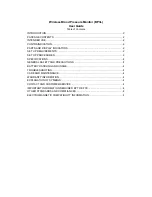
14
5. Microprocessor Circuit
The microprocessor circuit consists of the following four detailed circuits as shown in Fig.12.
1. Sync detect circuit
2. Front panel key data Input / Output (I/O)
3. Processing and memory
4.
Control
output
5.1 Sync detect circuit
The sync priority selector (I302) outputs H/V separate or composite sync signal to the sync processor inside the
microprocessor (I101). The sync processor has H/V polarity detector and sync separator for composite sync, H/V
frequency counter, dummy frequency generator, and outputs the processed H/V sync signal to the deflection processing
IC (I701) through the sync selector (I104).
5.2 Front panel key data Input / Output (I/O)
Microprocessor (I101) received user input from the front panel keys, which consists of: one menu key, four adjustment
keys (two pairs)
Contrast and Brightness are adjusted by four adjustment keys when OSD is disappeared.
Other feature requires controlling four adjustment keys when OSD is appeared by a menu key.
Current settings (including picture size, geometry, and color setting) are automatically stored to non-volatile memory.
The maximum memory capacity is for 48 presets including factory standard settings.
5.3 Processing and memory
I101 is an 8-bit microprocessor that equips with ROM and RAM for system program and sync processing circuit. Data
memory consists of one EEPROM chip (I102) for preset data.
5.4 Control output
Output of the microprocessor (I101) controls the deflection processing IC (I701) and the video pre-amplifier IC (I201),
the OSD control IC (I301), the rotation circuit, Horizontal drive correction circuit, the mute circuit, the sync priority
selector (I302), sync selector (I104), power save function. The deflection processing IC receives the signal through I
2
C
Bus to control the geometric function (H/V size and position, Pincushion, Trapezoid, Pin.Balance, Parallelogram, H/V
Moiré, Dynamic focus, Top/Bottom corner pincushion, V.Linearity, V.L.Balance). The video pre-amplifier IC receives the
signal through I
2
C Bus to control R/G/B Gain and Sub Contrast. The OSD control IC receives the signal through I
2
C Bus
to control R/G/B Cut off and Contrast, Brightness, Sub BKG, ACL, C-Contrast, and shows guidance for monitor control
function on screen display by generating video signal for OSD and feeding it to video pre-amplifier IC. Power save
function has Standby mode (main power supply has no output if either H sync or V sync is not supplied) and Off mode
(all power supply 5V have no output if both H sync and V sync are not supplied). The mute circuit brings video
output to black level when timing signal changes or the monitor goes into the power saving mode.
This chassis is capable of communication with external PC for factory adjustment through video connector (D-sub).
Summary of Contents for CM771ET
Page 24: ... 24 WIRING DIAGRAM ...
Page 43: ... 43 DISPLAY UNIT ASSEMBLY ...
Page 47: ... 47 ...
Page 48: ... 48 ...














































